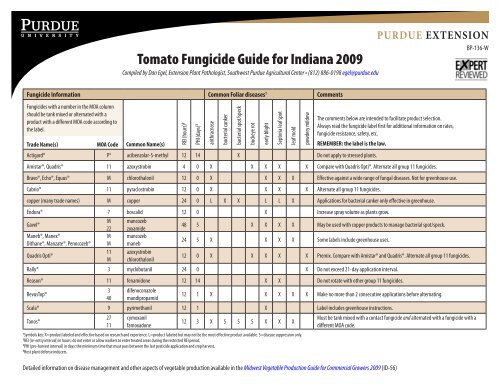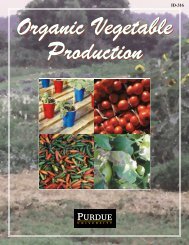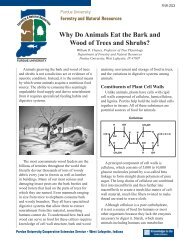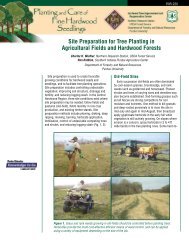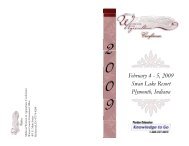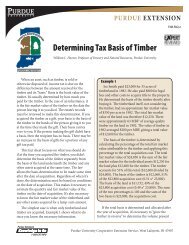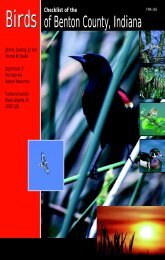Tomato Fungicide Guide for Indiana 2009 and Tomato Management ...
Tomato Fungicide Guide for Indiana 2009 and Tomato Management ...
Tomato Fungicide Guide for Indiana 2009 and Tomato Management ...
You also want an ePaper? Increase the reach of your titles
YUMPU automatically turns print PDFs into web optimized ePapers that Google loves.
<strong>Tomato</strong> <strong>Fungicide</strong> <strong>Guide</strong> <strong>for</strong> <strong>Indiana</strong> <strong>2009</strong><br />
Compiled by Dan Egel, Extension Plant Pathologist, Southwest Purdue Agricultural Center • (812) 886-0198 egel@purdue.edu<br />
<strong>Fungicide</strong> In<strong>for</strong>mation Common Foliar diseases 1 Comments<br />
<strong>Fungicide</strong>s with a number in the MOA column<br />
should be tank mixed or alternated with a<br />
product with a different MOA code according to<br />
the label.<br />
Trade Name(s) MOA Code Common Name(s) REI (hours)2<br />
PHI (days) 3<br />
Actigard® P 4 acibenzolar-S-methyl 12 14 X Do not apply to stressed plants.<br />
anthracnose<br />
bacterial canker<br />
bacterial spot/speck<br />
buckeye rot<br />
early blight<br />
Septoria leaf spot<br />
leaf mold<br />
powdery mildew<br />
Purdue extension<br />
The comments below are intended to facilitate product selection.<br />
Always read the fungicide label first <strong>for</strong> additional in<strong>for</strong>mation on rates,<br />
fungicide resistance, safety, etc.<br />
REMEMBER: the label is the law.<br />
Amistar®, Quadris® 11 azoxystrobin 4 0 X X X X X Compare with Quadris Opti®. Alternate all group 11 fungicides.<br />
Bravo®, Echo®, Equus® M chlorothalonil 12 0 X X X X Effective against a wide range of fungal diseases. Not <strong>for</strong> greenhouse use.<br />
Cabrio® 11 pyraclostrobin 12 0 X X X X Alternate all group 11 fungicides.<br />
copper (many trade names) M copper 24 0 L X X L L X Applications <strong>for</strong> bacterial canker only effective in greenhouse.<br />
Endura® 7 boscalid 12 0 X Increase spray volume as plants grow.<br />
Gavel®<br />
M<br />
22<br />
mancozeb<br />
zoxamide<br />
48 5 X X X X May be used with copper products to manage bacterial spot/speck.<br />
Maneb®, Manex®<br />
Dithane®, Manzate®, Penncozeb®<br />
M<br />
M<br />
mancozeb<br />
maneb<br />
24 5 X X X X Some labels include greenhouse uses.<br />
Quadris Opti®<br />
11<br />
M<br />
azoxystrobin<br />
chlorothalonil<br />
12 0 X X X X X Premix. Compare with Amistar® <strong>and</strong> Quadris®. Alternate all group 11 fungicides.<br />
Rally® 3 myclobutanil 24 0 X Do not exceed 21-day application interval.<br />
Reason® 11 fenamidone 12 14 X X Do not rotate with other group 11 fungicides.<br />
RevusTop®<br />
3<br />
40<br />
difenoconazole<br />
m<strong>and</strong>ipropamid<br />
12 1 X X X X X Make no more than 2 consecutive applications be<strong>for</strong>e alternating.<br />
Scala® 9 pyrimethanil 12 1 X Label includes greenhouse instructions.<br />
Tanos®<br />
27<br />
11<br />
cymoxanil<br />
famoxadone<br />
12 3 X S S S X X X<br />
1 Symbols key: X=product labeled <strong>and</strong> effective based on research <strong>and</strong> experience. L=product labeled but may not be the most effective product available. S=disease suppression only.<br />
2 REI (re-entry interval) in hours: do not enter or allow workers to enter treated areas during the restricted REI period.<br />
3 PHI (pre-harvest interval) in days: the minimum time that must pass between the last pesticide application <strong>and</strong> crop harvest.<br />
4 Host plant defense inducers.<br />
Must be tank mixed with a contact fungicide <strong>and</strong> alternated with a fungicide with a<br />
different MOA code.<br />
Detailed in<strong>for</strong>mation on disease management <strong>and</strong> other aspects of vegetable production available in the Midwest Vegetable Production <strong>Guide</strong> <strong>for</strong> Commercial Growers <strong>2009</strong> (ID-56)<br />
BP-136-W
<strong>Tomato</strong> <strong>Management</strong> Time Line<br />
Disease Winter/off-season Greenhouse Planting Fruit set Harvest<br />
anthracnose<br />
bacterial canker<br />
bacterial spot/speck<br />
buckeye rot <strong>and</strong><br />
Phytophthora root rot<br />
early blight/Septoria<br />
powdery mildew<br />
timber rot<br />
(white mold)<br />
leaf mold<br />
Rotate crops at least 2-3 years <strong>and</strong><br />
practice fall tillage.<br />
Rotate crops at least 3-4 years <strong>and</strong><br />
practice fall tillage.<br />
Rotate crops at least 2-3 years <strong>and</strong><br />
practice fall tillage.<br />
Rotate crops at least every 3 years<br />
<strong>and</strong> practice fall tillage. Avoid poorly<br />
drained soils. Use raised beds. Mulch<br />
may lessen buckeye rot’s impact<br />
Use crop rotations of at least 2-3 years<br />
<strong>for</strong> Septoria <strong>and</strong> 3-4 years <strong>for</strong> early<br />
blight.<br />
Crop rotations <strong>and</strong> fall tillage are only<br />
moderately important <strong>for</strong> powdery<br />
mildew.<br />
Long rotations with corn or small<br />
grains.<br />
Rotate crops at least 2-3 years <strong>and</strong><br />
practice fall tillage. Use sanitation in<br />
greenhouse tomatoes.<br />
Inspect seedlings <strong>for</strong> symptoms <strong>and</strong><br />
apply fixed copper compounds as<br />
needed.<br />
Inspect seedlings <strong>for</strong> symptoms <strong>and</strong><br />
apply fixed copper compounds as<br />
needed.<br />
Powdery mildew is more common<br />
on tomatoes grown to maturity in<br />
the greenhouse than those grown in<br />
the field.<br />
Timber rot may be common where<br />
tomatoes are grown yearly in the<br />
same soil such as under a greenhouse<br />
structure.<br />
Leaf mold is more common on<br />
tomatoes grown to maturity in the<br />
greenhouse than those grown in the<br />
field.<br />
Do not plant seedlings with<br />
bacterial canker symptoms.<br />
Reference to products in this publication is not intended to be an endorsement to the exclusion of others that may be similar. Persons using such products assume responsibility <strong>for</strong> their use in accordance with<br />
current directions of the manufacturer. Insect, disease, <strong>and</strong> weed control recommendations in this publication are valid only <strong>for</strong> <strong>2009</strong>. If the registration <strong>for</strong> any of these suggested chemicals changes during the<br />
<strong>2009</strong> growing year, we will in<strong>for</strong>m all area <strong>and</strong> county Purdue Extension workers. When in doubt about the use of any chemical, check with your Purdue Extension educator or chemical company representative.<br />
Purdue Agriculture<br />
Begin fungicide applications at or<br />
shortly be<strong>for</strong>e first fruit set.<br />
Inspect plants <strong>for</strong> bacterial canker<br />
symptoms.<br />
Do not plant seedlings with symptoms of bacterial spot/speck. Begin<br />
fixed copper applications on a 7-14-day schedule.<br />
Consider fungicide drench.<br />
Regular fungicide schedule<br />
may lessen buckeye rot<br />
effects.<br />
Consider specialized fungicides <strong>for</strong><br />
Phytophthora diseases.<br />
Begin protective fungicide applications on a 7-14 day schedule.<br />
Reduce humidity by venting greenhouses <strong>and</strong> pruning excess foliage. Use<br />
systemic fungicides.<br />
Inspect plants <strong>for</strong> timber rot symptoms.<br />
Control relative humidity by venting greenhouse <strong>and</strong> pruning. Labeled<br />
fungicides may help control leaf mold.<br />
It is the policy of the Purdue University Cooperative Extension Service that all persons have equal opportunity <strong>and</strong> access to its educational programs, services, activities, <strong>and</strong> facilities without regard to race, religion, color, sex, age,<br />
national origin or ancestry, marital status, parental status, sexual orientation, disability or status as a veteran. Purdue University is an Affirmative Action institution. This material may be available in alternative <strong>for</strong>mats.<br />
Inspect fruit <strong>for</strong> lesions.<br />
Inspect fruit <strong>for</strong> bacterial canker symptoms.<br />
Inspect fruit <strong>for</strong> bacterial spot/speck symptoms.<br />
Inspect fruit.<br />
Post-Harvest Care<br />
Firm-ripe tomatoes should be cooled to 45-50°F. Clean <strong>and</strong> disinfect all picking containers <strong>and</strong> equipment. Maintain chlorine/bromine levels at 75-150 ppm at a pH of 6.5-8.5 in recirculating water systems.<br />
Order or download materials from<br />
Purdue Extension • The Education Store<br />
www.extension.purdue.edu/store<br />
REV 2/09


